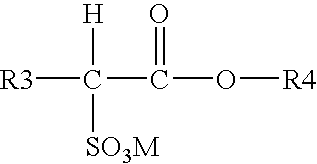Detergent compositions
a technology of detergent compositions and compositions, applied in the field of detergent compositions, can solve the problems that components typically take up most of the cost of detergent compositions, and achieve the effects of improving the overall detergency of detergent compositions, superior cleaning, and reducing the cost of components
- Summary
- Abstract
- Description
- Claims
- Application Information
AI Technical Summary
Benefits of technology
Problems solved by technology
Method used
Image
Examples
example 1
[0289] A standard European laundry powder detergent was prepared. It contained 15% of surfactant of which 6% was LAS, 3% was AES and 6% was nonionic surfactants. It further contained 47% builder comprising fatty acid, zeolite A, carbonate and silicate).
[0290] A launder meter wash was performed under standard European washing conditions with the following stains: grass stain on cotton (EMPA 164), mineral oil / black ink on cotton (EMPA 106), milk cacao on cotton (EMPA 112), pigment / sebum on cotton (Wfk 10D), vegetable oil / milk / ink on cotton (Wfk 10ppm), pre-aged egg yolk on cotton (Wfk 10eg), used motor oil on cotton / polyester (Wfk 20gm), and direct blue dye on cotton (Wfk DB71). The total detergent concentration was 5 g / litre.
[0291] The tests showed that by reducing the level of surfactant in the detergent composition to 25% of normal level, and replacing it with 0.01% protease enzyme protein derived from Bacillus clausii, it was possible to get a similar or better wash result than ...
example 2
[0292] A standard North American laundry liquid detergent was prepared. It contained 23% of surfactant of which 16% was AES, 5% was LAS and 2% was nonionic surfactants. It further contained 6% builder comprising soap, citric acid, DTPA and calcium formate.
[0293] A full scale wash was conducted under Standard North American conditions with the following stains: mineral oil / ink on cotton (EMPA 106), milk cacao on cotton (EMPA 112), grass on cotton (EMPA 164), pigment / sebum on cotton (Wfk 10D), vegetable oil / milk / ink on cotton (Wfk 10ppm), egg yolk on cotton (Wfk 10eg), used motoroil on cotton / polyester (Wfk 20gm), redwine on cotton (Wfk 20L), tomato ketchup on cotton / polyester (Wfk 20T), direct blue dye on cotton (Wfk DB71), colored olive oil on cotton (CS-4), butterfat on cotton (CS-10), lipstick on cotton / polyester (Wfk 20LS), makeup on cotton / polyester (Wfk 20MU), 15 different soils on cotton (EMPA 102), rice starch on cotton (CS-28), chocolate pudding on cotton (EMPA 170), shoe p...
example 3
[0295] A standard European laundry powder detergent was prepared. It comprised 0.004% protease protein from Bacillus clausii, 15% of surfactant of which 3% was AES, 6% was LAS and 6% was nonionic surfactants. It further comprised 47% builder comprising fatty acid, zeolite A, carbonate, silicate, and it comprised 5% polycarboxylate polymers.
[0296] A launder-o-meter wash under Standard European conditions was performed on cotton with carbon black / mineral oil stain (EMPA 101). The total detergent concentration was 5 g / litre.
[0297] The tests showed that by reducing the level of surfactants and the level of polymers in the detergent composition, and replacing them with 20 ECU of endo-cellulase from Bacillus subtilis / g detergent, it was possible to get an equivalent or better wash result than with the detergent composition with normal levels of surfactants and polymers.
Wash Result (higher is better)CompositionEMPA 101Normal level of surfactants & dispersing28polymers and no enzymeRedu...
PUM
| Property | Measurement | Unit |
|---|---|---|
| size | aaaaa | aaaaa |
| concentration | aaaaa | aaaaa |
| temperature | aaaaa | aaaaa |
Abstract
Description
Claims
Application Information
 Login to View More
Login to View More - R&D
- Intellectual Property
- Life Sciences
- Materials
- Tech Scout
- Unparalleled Data Quality
- Higher Quality Content
- 60% Fewer Hallucinations
Browse by: Latest US Patents, China's latest patents, Technical Efficacy Thesaurus, Application Domain, Technology Topic, Popular Technical Reports.
© 2025 PatSnap. All rights reserved.Legal|Privacy policy|Modern Slavery Act Transparency Statement|Sitemap|About US| Contact US: help@patsnap.com



